Smoothies seem like the perfect way to meet our daily fruit and vegetable goals and get a hit of vitamins and minerals first thing in the morning.
In theory, they’re the perfect answer for those who don’t have time to prepare a healthy meal before work and they’re a much better snack option than cookies.
But are they really all they’re cracked up to be?
While some credit a smoothie for breakfast with their all-round good health, other health aficionados won’t touch them.
I decided to find out once and for all if smoothies for breakfast are a healthy way to start the day so I did some digging – here’s what I found out.
Food & Vegetable Intake
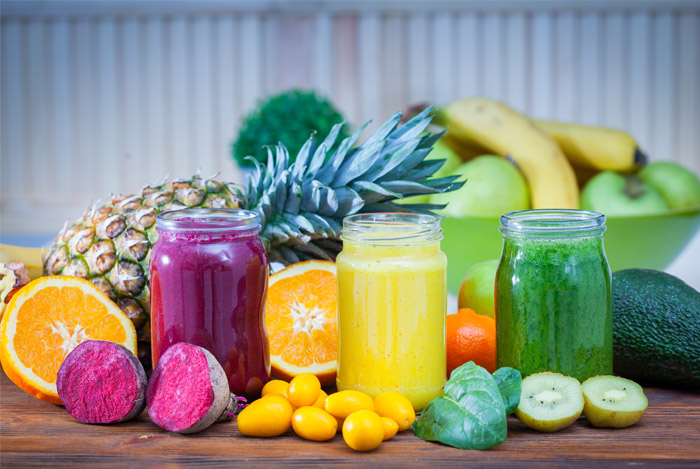 There’s a lot of debate around how many servings of fruits and vegetables we should be eating daily. We’ve all heard of the five-a-day rule, but newer research says it should be even more.
There’s a lot of debate around how many servings of fruits and vegetables we should be eating daily. We’ve all heard of the five-a-day rule, but newer research says it should be even more.
One thing that’s for sure is that Americans aren’t even close to hitting their targets.
A whopping 87% of Americans don’t meet their recommended fruit consumption, and 91% don’t eat enough vegetables, says a 2015 CDC report.
This is a shocking statistic, don’t you think?
It’s especially worrying as a 2014 study, published in Journal of Epidemiology & Community Health, found that people who ate seven or more portions of fruit and vegetables a day had a 42% lower risk of death at any point in time than those who ate less than one portion.
Smoothies are a great way to increase fruit and vegetable intake – especially if you can’t stomach the thought of munching on the whole food version, or are just too busy to do so.
Liquid fruit and vegetables can also be an effective (and sneaky) way of getting kids to hit their targets.
In a 2015 study, it was found that only 4.3% of kids eating a school breakfast had a serving of fruit. When the school offered morning smoothies, that number shot up to 45%.
Calories
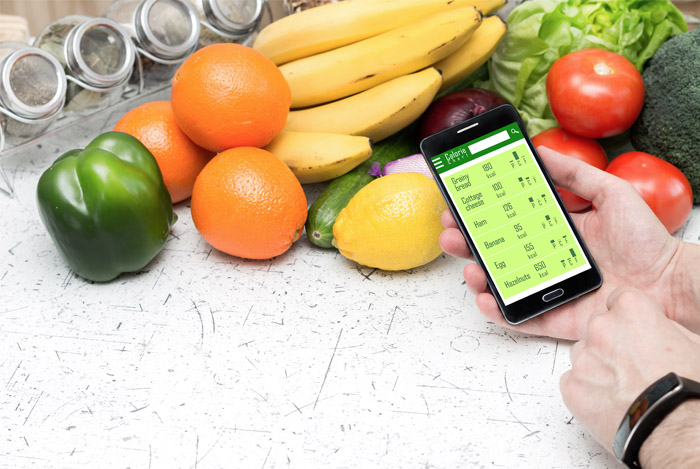 This is one area where smoothies come under a lot of fire – some can pack in more calories than a dessert – and that’s no exaggeration.
This is one area where smoothies come under a lot of fire – some can pack in more calories than a dessert – and that’s no exaggeration.
Planet Smoothie’s 22 oz PBJ packs in 710 calories, while their 32 oz serving has 990 calories. Even the healthier sounding Planet Pro® Lite Banana & PB contains 540 calories per 22 oz or 710 per 32 oz.
Smoothie King’s ‘The Hulk Strawberry’ shake contains 964 calories per 20 oz serving, or 1,446 per 32 oz.
Even if you ‘Make it Skinny’ you’ll still be imbibing 864 calories in a 20 oz or 1,296 in a 32 oz!
By comparison, a McDonald’s Hot Fudge Sundae has just 330 calories.
Of course, there are plenty of low calorie smoothie options out there, like the Starbucks Sweet Greens Smoothie at 170 calories, or their Strawberry flavor at 200 calories.
Sugar
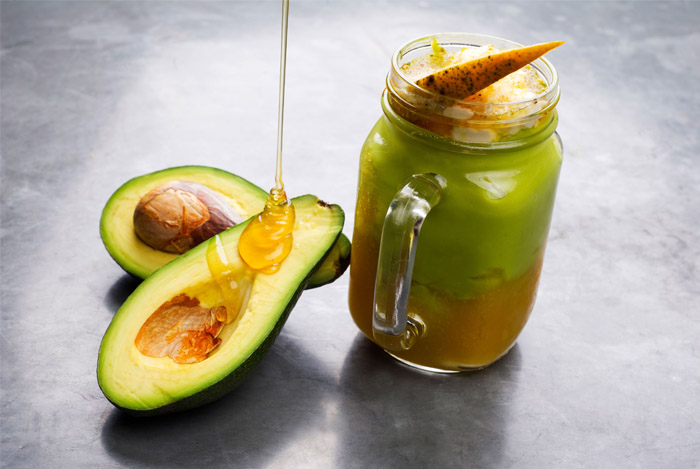 Containing ingredients like fruits, fruit juices, honey, agave syrup, dates, flavored yogurts and more, smoothies can quickly add up in terms of their sugar content.
Containing ingredients like fruits, fruit juices, honey, agave syrup, dates, flavored yogurts and more, smoothies can quickly add up in terms of their sugar content.
Take, for example, Starbuck’s Strawberry Smoothie. While it does well on the calorie front, it’s less impressive when you look at its sugar content.
At 41 grams per shake, it has 2 grams more sugar than a 12 oz can of Coca-Cola.
Smoothie King’s Hulk Strawberry blend has 125 grams of sugar per standard 20 oz serving, while their Orange Ka-Bam has 108 grams.
Even the ironically named Angel Food on the Slim Blend list has 75 grams of sugar.
To put that in perspective, the American Heart Association recommends that men should eat no more than 37.5 grams of sugar a day, and women should have no more than 25 grams – or one fifth of a Hulk Strawberry shake!
Fat
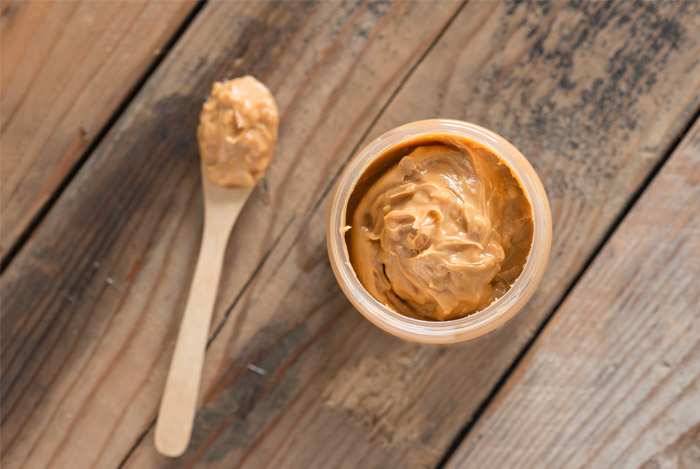 You may wonder if smoothies have any fat in them – after all, they’re just blended fruits, vegetables and a few extras.
You may wonder if smoothies have any fat in them – after all, they’re just blended fruits, vegetables and a few extras.
But when the extras consist of things like peanut butter, yogurt, avocado, coconut milk or even coconut oil, then fat content can add up quickly.
Of course, dietary fat is an important and even vital part of our diets, but too much isn’t good. If you blend your own smoothies, or buy ones with a sensible amount of fat sources, then you have nothing to be worried about on the fat front.
But if you routinely sip on a 22 oz PBJ from Planet Smoothie for breakfast, then you’re looking at 28 grams of fat before the day has even begun.
If your favorite is a Hulk Strawberry or Hulk Vanilla then that’s 32 grams of dietary fat.
If we go by the guidelines that 20% to 35% of total calories should come from fat, then 32 grams of fat works out at 73% of the recommended daily amount.
Effects on Blood Sugar
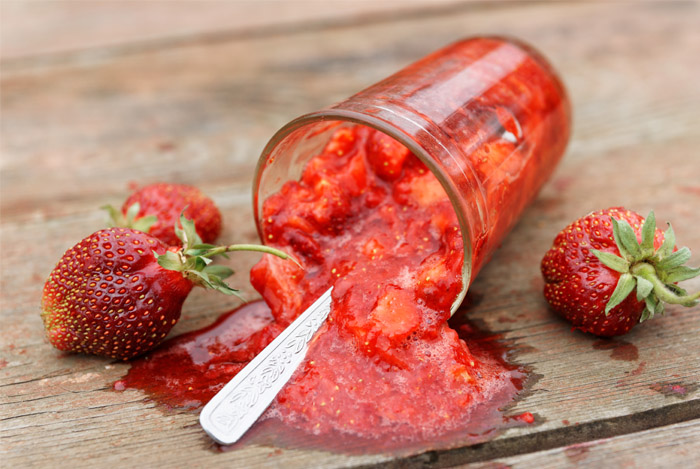 When we take bananas, orange juice, dates, and other fruits and blend them up, we’re creating a drink with a high glycemic index (GI).
When we take bananas, orange juice, dates, and other fruits and blend them up, we’re creating a drink with a high glycemic index (GI).
Eating lots of high GI foods, which cause strong and rapid spikes in blood sugar, can lead to an increased risk for type 2 diabetes, heart disease and obesity.
In addition, changing the composition of the food (i.e. blending it) can change the way our bodies digest it.
One study, published in the American Journal of Clinical Nutrition, looked at the metabolic responses to different forms of food.
The researchers found that, with certain foods (like rice), blending it prior to eating it can cause the body to react with a sharper and faster spike in blood sugar.
Effects on Satiety
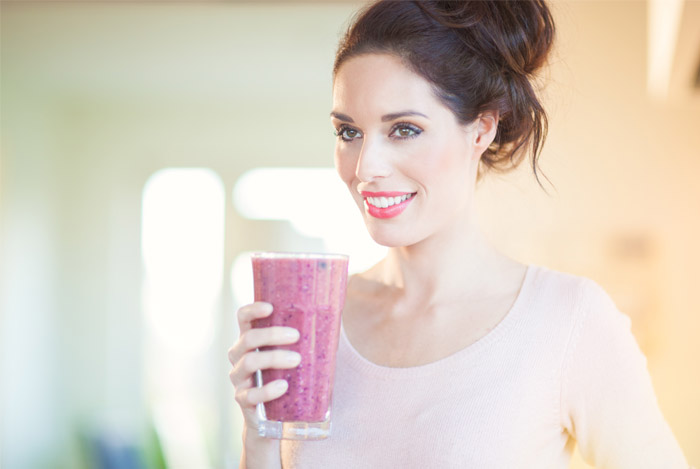 The very act of chewing food is thought to help with satiety (the feeling of fullness). With a smoothie, there is no chance to chew – meaning we may feel less full, or get hungry quickly, despite gulping down a 22 oz liquid meal.
The very act of chewing food is thought to help with satiety (the feeling of fullness). With a smoothie, there is no chance to chew – meaning we may feel less full, or get hungry quickly, despite gulping down a 22 oz liquid meal.
It also takes more time and effort to chew than to drink.
This added chew-time may help you stay fuller for longer – one study found that people exhibited better levels of satiety when they ate at a slow pace. They also consumed 10% fewer calories throughout the day.
Further research shows that, if you eat a liquid form of a solid food, you may consume more calories later – because the liquid energy doesn’t kill your appetite in the same way the solid food does.
When participants were asked to eat either a liquid or solid form of a particular food on separate days, it was found that energy intake (calories) was between 12% and 19% higher on the days the liquid form was ingested.
This occurred whether the food given was high carbohydrate (watermelon and watermelon juice); high protein (cheese and milk); or high fat (coconut meat and coconut milk).
On the other hand, a well-balanced smoothie with the right ingredients may well boost your feelings of satiety.
2015 research, published in the journal Appetite, found that whey protein (a common smoothie ingredient) is ‘highly satiating’ in resistance training athletes.
Other research suggests that drinking a green-plant shake in the morning may significantly lower hunger throughout the day and promote weight loss.
Effects on Digestion
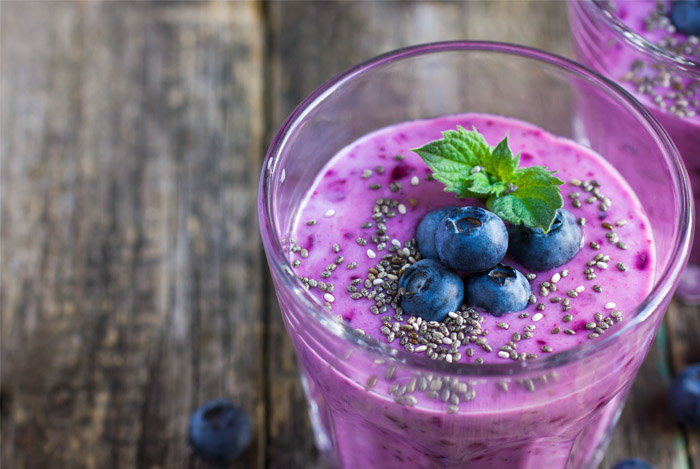 Digestion requires a great deal of energy from our bodies, especially if they need to process improperly chewed food, which is why smoothies are touted as being healthier for our digestive systems – as our blender has done a better job breaking down food than our teeth ever could.
Digestion requires a great deal of energy from our bodies, especially if they need to process improperly chewed food, which is why smoothies are touted as being healthier for our digestive systems – as our blender has done a better job breaking down food than our teeth ever could.
Once broken down, our saliva and digestive juices can get to work and begin the digestive process.
But that’s where the ease of smoothies on digestion is called into question.
When we chug a liquid meal, we don’t let it linger in our mouths, mixing our food with the saliva.
Saliva contains digestive enzymes, so the longer we chew, the more time these enzymes have to start breaking down our food, making digestion easier on the stomach and small intestine.
So, while smoothies bypass the issue of improperly chewed food, they also bypass our saliva – the first step in the digestive process.
Smoothies Can Be a Good Option…
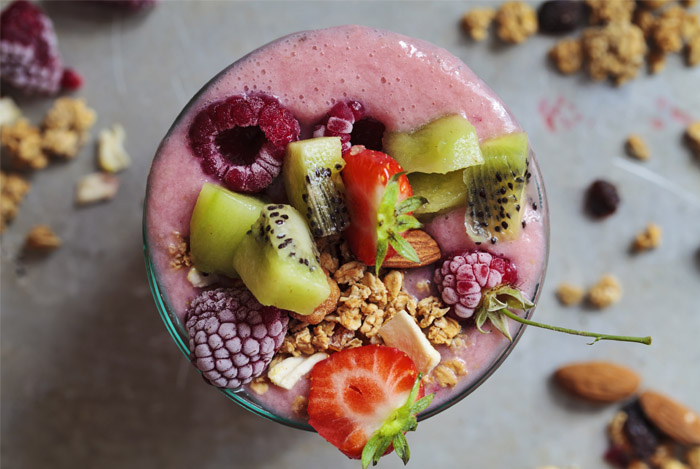 Overall, smoothies can work for some people, and in some situations.
Overall, smoothies can work for some people, and in some situations.
If you’re the kind of person who struggles to fit in fruit and vegetables every day, or who skips breakfast because you’re in a hurry, then smoothies may be for you.
Thanks to the fiber, vitamins, minerals and antioxidants found in fresh produce, they’re a lot healthier than a stack of pancakes or a bacon sandwich.
If they’re made just right – with plenty of greens, protein and a sensible amount of healthy fat – then they can be a pretty nutritious meal.
Smoothies can also be a handy snack, as long as the calories don’t reach the dizzying heights of some of the store-bought varieties.
…But There Are Better Options
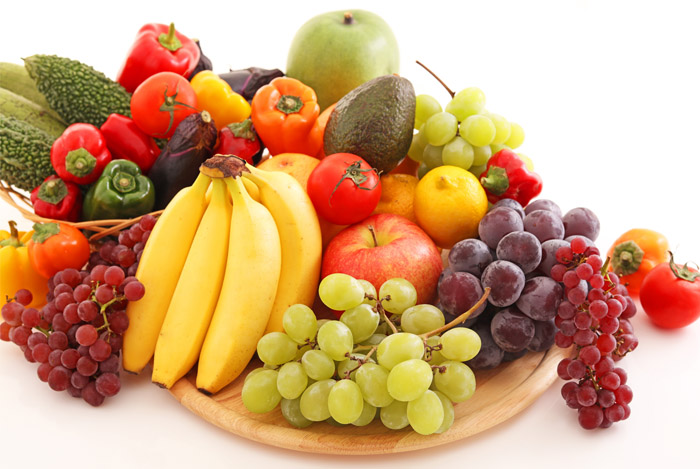 Given the concern about the satiating abilities of smoothies, and the gray areas around their digestive benefits, there are better options out there.
Given the concern about the satiating abilities of smoothies, and the gray areas around their digestive benefits, there are better options out there.
Namely, fruits and vegetables and other healthy foods in their whole form, eaten exactly as nature intended.
By chewing on an apple, snacking on some nuts and adding avocado to your mixed greens, you’re getting all the components of the smoothie but as a whole food – which means you eat it slower, savor it more and basically get more bang for your buck.
How to Make a Healthier Smoothie
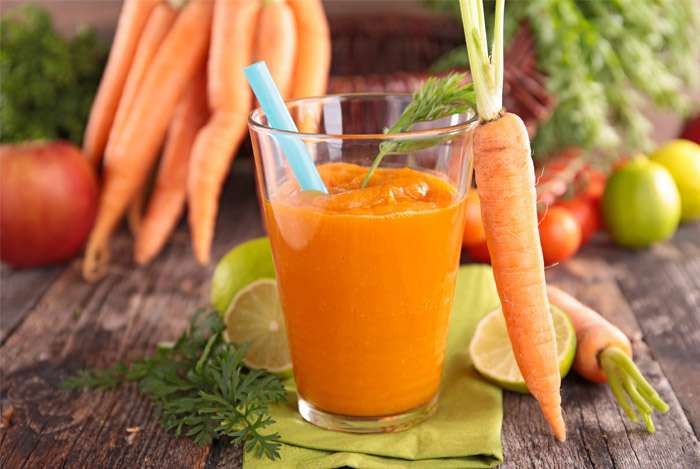 If you’re a die-hard smoothie lover, you’ll be happy to hear that it’s easy to lighten-up your favorite breakfast.
If you’re a die-hard smoothie lover, you’ll be happy to hear that it’s easy to lighten-up your favorite breakfast.
Here are a few tips:
- Don’t use fruit juice as a base. A recent analysis of fruit juices found that they contain a huge amount of sugar. For example, Minute Maid’s 100% apple juice has more fructose per liter than Pepsi, Sprite, Coca-Cola, 7-Up or Dr. Pepper. Water or almond milk are better smoothie bases.
- Go easy on the fruit – a good ratio to follow is 70% vegetables to 30% fruit, according to Laura Jeffers, a registered dietitian at Cleveland Clinic.
- Avoid adding sugar sources like dates, honey or agave syrup – the fruit should be sweet enough.
- Include fats and protein. These help offset the effects of the sugar on your body. You could try avocado, nut butter, chia seeds, or whey or hemp protein.
- Keep an eye on the calorie count, fat and sugar levels. It’s worth knowing exactly how many calories you’re consuming from your favorite smoothie combination. That way you can see if it fits in with your weight goals, or needs a little tweaking!
Final Thoughts
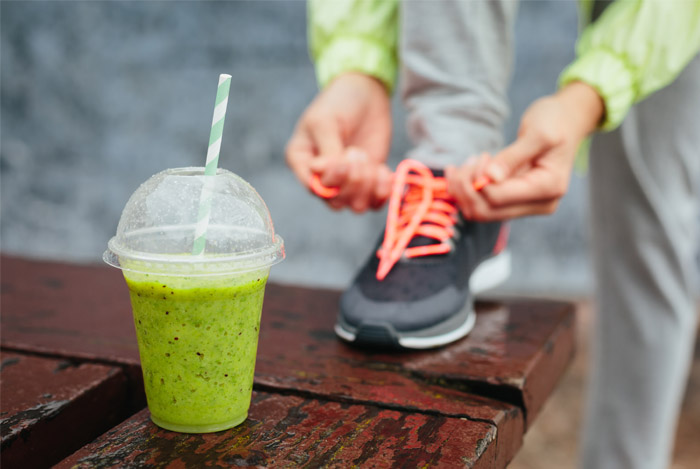 Smoothies have a lot going for them.
Smoothies have a lot going for them.
They’re an excellent way to hit your daily fruit and vegetable targets and they can be a quick and easy breakfast idea for people who would otherwise skip this most important meal.
Furthermore, some research has found that protein shakes and green smoothies boost satiety and help with weight loss.
On the other hand, they can be high in calories and sugar, which leads to blood sugar crashes and weight gain.
If you make healthy smoothies using no added sources of sugar, mainly vegetables and healthy amounts of protein and fat, they may have a place in an otherwise well-balanced diet.
Given all the health benefits that fresh produce provides, I say if you can’t eat your fruits and veggies, you might as well drink them!
What are your thoughts on smoothies – are you a fan?
The post Are Smoothies for Breakfast Really Healthy? appeared first on Nutrition Secrets.
http://www.nutritionsecrets.com/are-smoothies-for-breakfast-really-healthy/
No comments:
Post a Comment